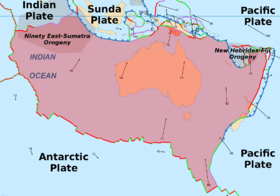Our website is made possible by displaying online advertisements to our visitors.
Please consider supporting us by disabling your ad blocker.
Australian plate
| Australian plate | |
|---|---|
 | |
| Type | Major |
| Approximate area | 47,000,000 km2 (18,000,000 sq mi)[1] |
| Movement1 | northeast |
| Speed1 | 62–70 mm/year |
| Features | Australia, New Guinea, New Zealand, Indian Ocean |
| 1Relative to the African plate | |
The Australian plate is a major tectonic plate in the eastern and, largely, southern hemispheres. Originally a part of the ancient continent of Gondwana, Australia remained connected to India and Antarctica until approximately 100 million years ago when India broke away and began moving north. Australia and Antarctica had begun rifting by 96 million years ago[2] and completely separated a while after this, some believing as recently as 45 million years ago,[3] but most accepting presently that this had occurred by 60 million years ago.[4]
The Australian plate later fused with the adjacent Indian plate beneath the Indian Ocean to form a single Indo-Australian plate. However, recent studies suggest that the two plates have once again split apart and have been separate plates for at least 3 million years and likely longer.[5] The Australian plate includes the continent of Australia, including Tasmania, as well as portions of New Guinea, New Zealand and the Indian Ocean basin.
- ^ "Sizes of Tectonic or Lithospheric Plates". Geology.about.com. 2014-03-05. Archived from the original on 2016-06-05. Retrieved 2015-12-25.
- ^ McLoughlin, S. (2001). "The breakup history of Gondwana and its impact on pre-Cenozoic floristic provincialism". Australian Journal of Botany. 49 (3): 271–300. doi:10.1071/BT00023. Retrieved 21 May 2023.
- ^ "New Look at Gondwana's Breakup". Livescience.com. 2013-07-05. Retrieved 2015-12-25.
- ^ "ODSN Plate Tectonic Reconstruction Service". Retrieved 2023-05-24.
- ^ Cite error: The named reference
Stein2002was invoked but never defined (see the help page).
Previous Page Next Page


